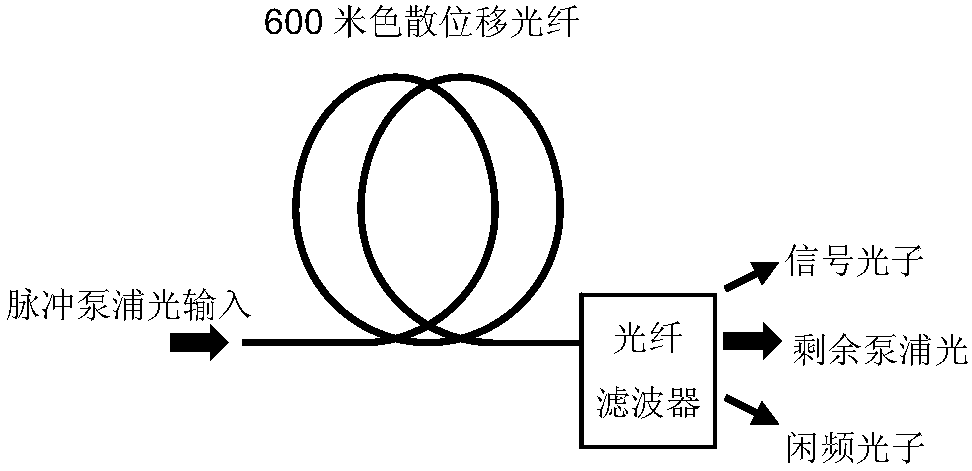Method for improving mode purity and collection efficiency of quantum-correlated photon pair
A technology of quantum correlation and mode purity, which is applied in the field of optical quantum, can solve the problems of complex preparation process of nonlinear media, and achieve the effect of improving time mode purity and collection efficiency, insensitive to fluctuations of dispersion parameters, and simple preparation process
- Summary
- Abstract
- Description
- Claims
- Application Information
AI Technical Summary
Problems solved by technology
Method used
Image
Examples
Embodiment 1
[0041] Embodiment 1: Comparison of characteristics of associated photon pairs produced by non-cascaded and cascaded spontaneous four-wave mixing processes
[0042] In this embodiment, the non-cascaded spontaneous four-wave mixing process and the cascaded spontaneous four-wave mixing process in the dispersion-shifted fiber are compared. By simulating the temporal patterns and collection efficiencies of associated photon pairs generated in the two cases, it is demonstrated that cascaded spontaneous parametric processes can improve the temporal pattern and collection efficiency of associated photon pairs. Figure 1a and Figure 1b Shown is a schematic diagram comparing the non-cascaded and cascaded spontaneous four-wave mixing process to generate correlated photon pairs.
[0043] In the case of non-cascaded spontaneous four-wave mixing, such as Figure 1a As shown, the nonlinear medium used is a 600m-long dispersion-shifted fiber, which is pumped by pulsed light, and correlated p...
Embodiment 2
[0047] Embodiment 2: Announcement type single photon source based on cascade spontaneous four-wave mixing process
[0048] The declared single photon source of this embodiment is based on a cascaded structure composed of a section of nonlinear medium, a section of dispersion medium and a section of nonlinear medium in sequence. The device is as image 3 shown. The optical fiber and device parameters in the device are the same as those in Example 1. For the signal and idler photon pairs generated in the cascaded four-wave mixing process, the idler photon is detected by a single photon detector, and the detection signal of the detector is used as the announcement signal, so that the signal photon is projected to the single photon state above, as the output of a declared single-photon source.
[0049] As pointed out in Example 1, both the mode purity and the collection efficiency of correlated photon pairs generated by the cascaded spontaneous four-wave mixing process are impro...
Embodiment 3
[0050] Embodiment 3: Polarization-entangled photon pair generation device based on cascaded spontaneous four-wave mixing process
[0051] In this embodiment, the cascaded spontaneous four-wave mixing process of bidirectional pumping is used to generate polarization-entangled photon pairs. The basic device is as follows Figure 4 shown. The cascaded structure for generating photon pairs consists of a section of dispersion-shifted fiber, a section of single-mode fiber and a section of dispersion-shifted fiber in sequence. The parameters of fiber, pump light and filter are the same as those in Embodiment 1.
[0052] The pulsed pump light enters the polarization beam splitter with a 45-degree linear polarization direction and is split into two beams. A beam whose polarization direction is parallel to the paper is input into the cascade structure clockwise, through the cascade four-wave mixing process, the signal and idler frequency associated photon pairs with the same polarizati...
PUM
 Login to View More
Login to View More Abstract
Description
Claims
Application Information
 Login to View More
Login to View More - R&D
- Intellectual Property
- Life Sciences
- Materials
- Tech Scout
- Unparalleled Data Quality
- Higher Quality Content
- 60% Fewer Hallucinations
Browse by: Latest US Patents, China's latest patents, Technical Efficacy Thesaurus, Application Domain, Technology Topic, Popular Technical Reports.
© 2025 PatSnap. All rights reserved.Legal|Privacy policy|Modern Slavery Act Transparency Statement|Sitemap|About US| Contact US: help@patsnap.com



